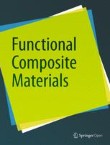Flexible and stretchable electronics is an emerging field of great interest for wearable computing devices, sensors, soft robotics, flexible antennas, etc. The collection will feature new developments in composite materials for substrates, conductive printable inks, conductive stretchable or flexible materials systems, manufacturing processes, design, modeling and materials properties (mechanical and electrical).
Guest Editors
Joey Mead, University of Massachusetts Lowell, USA
Samuel Kenig, Shenkar College, Israel
Hanna Dodiuk, Shenkar College, Israel
Submission deadline
1 June 2022
Submission instructions
Before submitting your manuscript, please ensure you have carefully read the submission guidelines for Functional Composite Materials. The complete manuscript should be submitted through the Functional Composite Materials submission system. To ensure that you submit to the correct thematic series please select the appropriate thematic series in the drop-down menu upon submission. In addition, please include the name of the collection in your cover letter. All submissions will undergo rigorous peer review and accepted articles will be published within the journal as a collection.
Open access
All articles published by Functional Composite Materials are made freely and permanently accessible online immediately upon publication, without subscription charges or registration barriers. Further information about open access can be found here.
As authors of articles published in Functional Composite Materials you are the copyright holders of your article and have granted to any third party, in advance and in perpetuity, the right to use, reproduce or disseminate your article, according to the SpringerOpen copyright and license agreement.
For those of you who are US government employees or are prevented from being copyright holders for similar reasons, SpringerOpen can accommodate non-standard copyright lines. Please contact us if further information is needed.
Submissions will also benefit from the usual advantages of open access publication:
- Rapid publication: Online submission, electronic peer review and production make the process of publishing your article simple and efficient.
- High visibility and international readership in your field: Open access publication ensures high visibility and maximum exposure for your work - anyone with online access can read your article
- No space constraints: Publishing online means unlimited space for figures, extensive data and video footage
- Authors retain copyright, licensing the article under a Creative Commons license: articles can be freely redistributed and reused as long as the article is correctly attributed.
Article-processing charges and funding
Functional Composite Materials levies an article-processing charge (APC) for each article accepted for publication. Springer Nature has numerous agreements around the world to fund the APC, which may mean you are eligible for coverage. Please visit one of the following links for more information:
- DEAL agreement for Germany
- BIBSAM agreement for Sweden
- Agreement for Hungary
- Agreement for University of California
- Other institutional-level agreements
If you are not covered by one of the above, please visit our funding support page as you may have access to funds at your institution.
For authors that do not have any access to funds, Springer Nature will consider requests for waivers on a case-by-case basis for cases of financial need. For more information, see here (under "Article-processing charges"). Springer Nature offers APC waivers to papers whose corresponding authors are based in countries classified by the World Bank as low-income economies (for the current list, see here).
